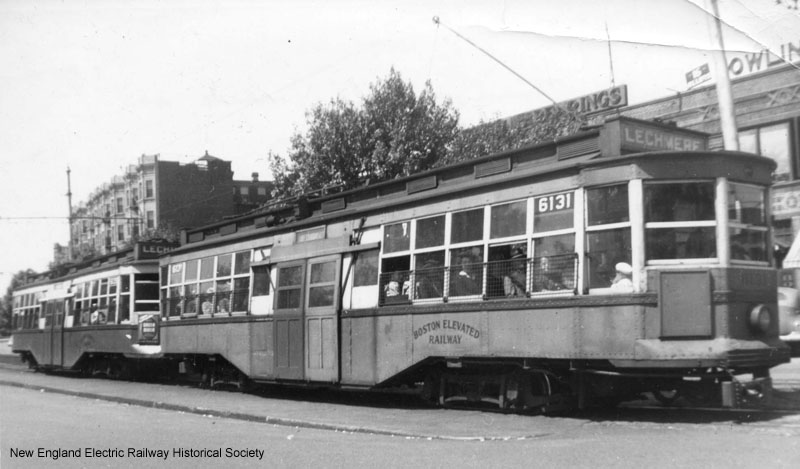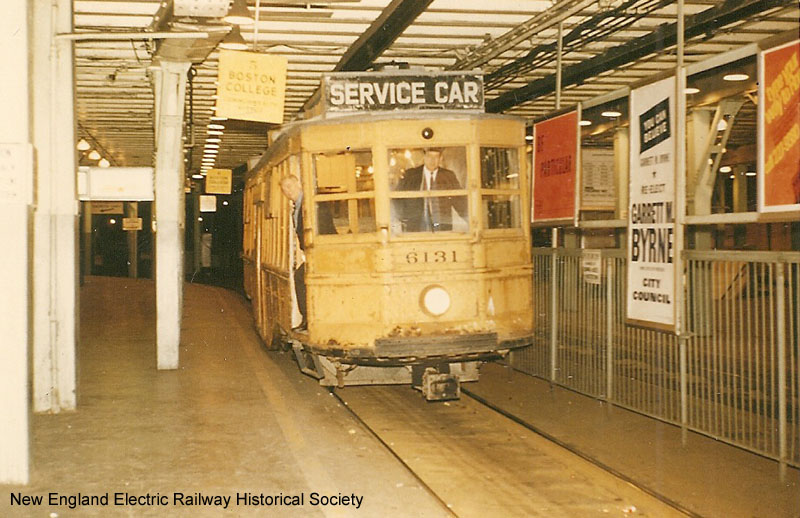
- Builder
- G. C. Kuhlman Car Co.
- Description
- Center entrance
- Secondary Use
- Railway maintenance
- Type
- City and Suburban Streetcars
- Year
- 1919
- Retired from Service
- 1974
- Acquired by the Museum
- 1974
- Note
- Further restoration, particularly for the interior, is needed. As of September 2016, No. 6131 is in the Town House restoration shop.
- Fund
- 576
Boston Elevated Ry. 6270
From Boston, Massachusetts
History
In 1917, the Boston Elevated purchased 100 center-entrance, multiple-unit cars for service in the East Boston Tunnel. In 1919, BERy added another 200 center-entrance cars, including No. 6131. The Elevated did not immediately take advantage of their multiple-unit capability, leading to a final order of 105 simpler, single-unit cars. The center-entrance cars were unique to Boston. The wide center doors were used for both entrance and exit, passengers passing the conductor and depositing their fares before moving to a seat or to stand at either end of the car. The wide doors, with a low entry close to street level, made these cars particularly useful for handling large crowds of riders. In a unique feature, the trolley pole bases were at either end of the monitor roof. The trolley ropes came down to catchers at the conductor’s stand in the center of the car. A slot like trap door opened so the conductor could open it and reset the pole. Rising crew costs in the 1920s and 1930s made single unit operation of these two-man cars, economically unfeasible, so the cars were focused on the subway-surface operations, where the multiple-unit capability was appreciated. In general, the cars ran in three car trains on Beacon Street and Commonwealth Ave. and in two car sets on the Watertown and Arborway routes. These routes dominated the service in the Central Subway, moving hundreds of passengers per trip. Most of these cars were replaced by multiple-unit PCCs in the mid 1940s, and the few remaining earned their keep on rush-hour extras and ball-park runs until 1953.
Car 6131 was retired in 1945 and converted into a sand car. No. 6131 continued in maintenance service under Metropolitan Transit Authority ownership in 1947 and Massachusetts Bay Transportation Authority ownership in 1964.
No. 6131 came to Seashore in 1974 after its usefulness as a sand car had ended. At the same time, Seashore acquired two of the single-unit center-entrance cars – Nos. 6309 and 6365 – which had also been converted to sand cars. In addition, Seashore had acquired another Boston center-entrance car, No. 6270, in 1953. Time and salt had taken its toll on all of these center-entrance cars. Seashore scrapped No. 6365 at Arborway in Boston and salvaged the parts. Seashore later scrapped No. 6309. Since No. 6270 was still a passenger car, the museum decided to restore No. 6131 first, and use No. 6270 as a model for the missing pieces. In 1984, Seashore received a Federal Institute of Museum Services grant for restoration of No. 6131. Seashore removed the sand hopper and installed new steel side sills and frame. In 2009, No. 6131 returned to the Town House restoration shop for additional restoration. In 2016, Seashore did restoration work on the windows using No. 6270 as a model. Having two center-entrance cars gives Seashore the potential to run them in their historical multiple unit operation. Nos. 6131 and 6270 are the only surviving Boston MU center-entrance cars.
Technical Information
- Seats: 56
- Control: ABPC(32A)
- Brakes: General Electric EP
- Compressor: DH-16
Trucks
- Number: 2
- Manufacturer: Brill
- Model: 77E-1
Motor
- Number: 4
- Manufacturer: General Electric
- Model: 247H
Weight and Dimensions
- Length: 48’ 10.00"
- Width: 8’ 9.00"
- Height: 11’ 9.00"
- Weight: 44420 lbs.
Additional Images


© 1998 - 2025 New England Electric Railway Historical Society. All Rights Reserved.